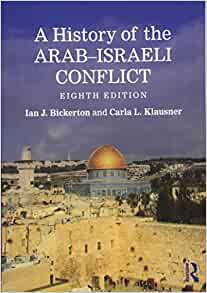A History of the Arab-Israeli Conflict, 8th Edition
A History of the Arab-Israeli Conflict, 8th Edition Reviewed by: Jack Sigman, Ph.D. student, Gratz College As a preface, I used the earlier editions as a basic reference throughout my BA and MA studies in international relations. Those texts were used in conjunction with Mark Tessler’s A History of the Israeli-Palestinian Conflict and Charles Smith’s Palestine and the Arab-Israeli Conflict: A History with Documents. All three are basic textbooks with some interpretive narrative reflecting the viewpoint of the authors and not necessarily those of the actors, although many of those viewpoints are included. Not having purchased the 7th edition, I am comparing the 8th to the 6th. The 8th edition covers eight additional years, so it has expanded from 427 pages to 587. Wherein the earlier edition stopped at the re-election of Abbas as head of Fatah, the 8th includes the Syrian Civil War, the “Arab Spring,” the Egyptian reversal, The Trump election, as well as the non-progress in the still stalemated “peace process.” One cannot overemphasize the dearth of knowledge of the history of this particular conflict, despite the heavy publicity in mainstream media and the Internet of every act that takes place, that is typical of today’s (and yesterday’s) college students. This book is a partial answer to eradicate that paucity. Accordingly, the introduction includes defining the people, the religions, and the land. The rest of the book is broken down into various timelines starting with 19th century Ottoman Palestine. The next significant time frame includes World War One, the Balfour Declaration, awarding the Palestinian Mandate to Great Britain, and the events in the region prior to the start of World War Two. This is followed by a chapter dealing with the aftermath of that war, the partition vote, and the Palestinian Civil War. The following four chapters deal with the first Arab-Israeli War (1948), the Sinai War (1956), the Six Day War (1967), and the Yom Kippur War (1973). The next nine chapters go through the various failed peace plans, the Lebanon War, the Intifadas, the Oslo years, the disengagement from Gaza, and the three Gaza Wars. Noteworthy is the evenhanded treatment of the failure, by both sides, to come to a negotiated peace settlement. There are red lines that are likely to never be crossed and these are discussed in length. As with the earlier editions, there are numerous maps and documents which are of significant aid to navigating the text. The quality of the writing is clear and concise, and the supporting documents, included in each chapter, are meaningful and relevant. However, there are limitations. As with any text attempting to cover over a century of material, some events are not covered in adequate detail. There are some significant errors. A notable one is a Christian Zionist slogan that was adopted by Jewish Zionists, “A land without a people for a people without a land.” In the book (p. 28), it is rendered “A land without people.” The simple declarative changes the meaning entirely. The difference is that it was recognized that people lived there, but it was not inhabited by an ethnicity that differed from Syrian, in which it was administratively connected. Additionally, while the authors discuss the various other areas considered by the early Zionist leadership, there is no explanation as to why any area, other than the Palestinian region, were options, nor why they were considered. The author’s conclusions attempt to contain the whirlwind. There are no concrete suggestions on how to end what has become one of the longest conflicts in the Middle East, if not in the world. Regardless, this is a balanced book on the origins of the conflict and the history of its continuance through 2017. It is an excellent source of information and a valuable addition to the college classroom. Accordingly, it is not intended to be an end in itself but to be a path to further study of the individual events. |



